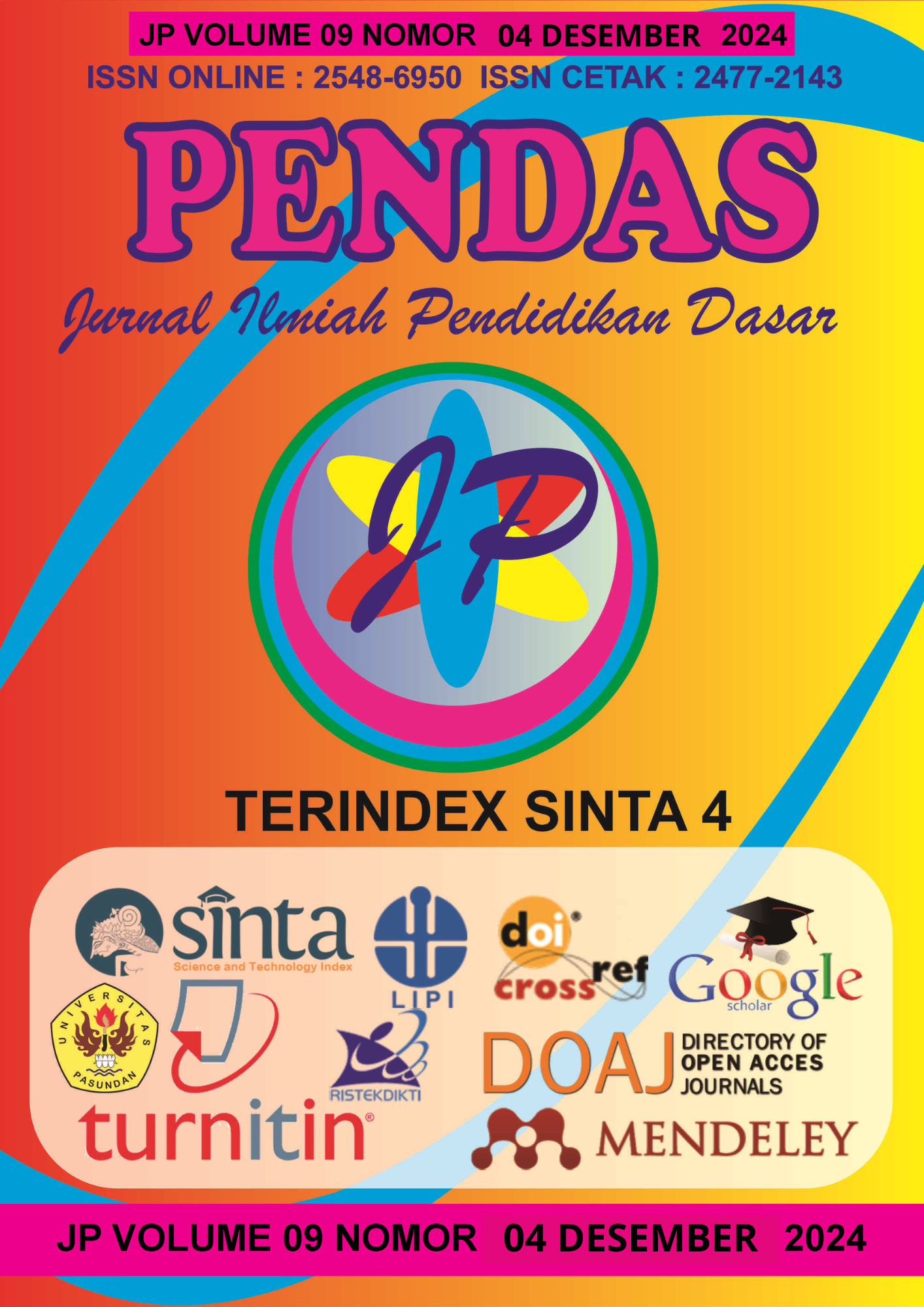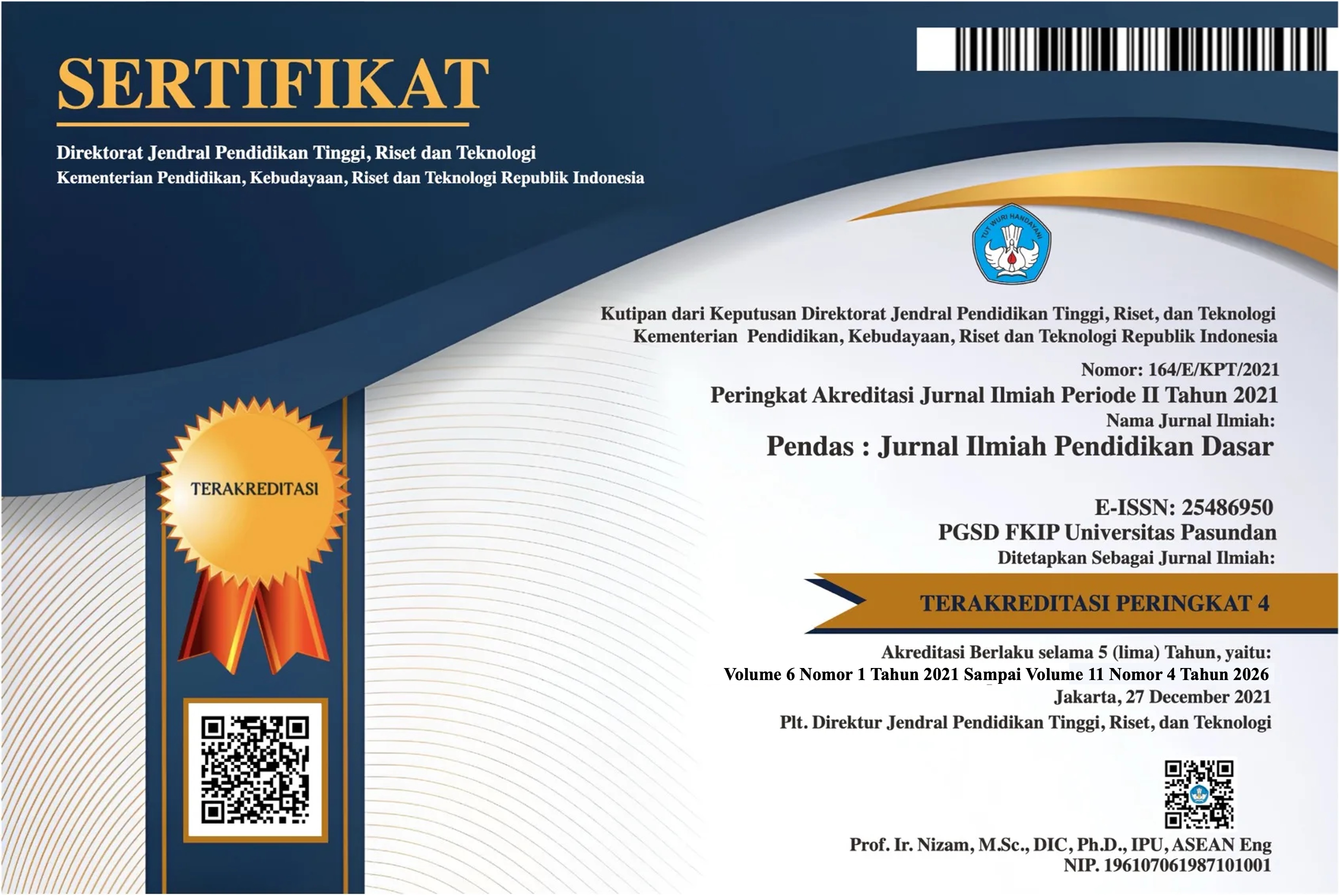KOMPARASI STRUKTUR KOMUNIKASI PADA HEWAN DAN MANUSIA: IMPLIKASINYA DALAM PENGAJARAN LINGUISTIK DI SEKOLAH DASAR
DOI:
https://doi.org/10.23969/jp.v9i04.19575Keywords:
animal communication, human commmunication, teaching linguisticsAbstract
This study aims to analyse the comparison of communication structures between animals and humans and its implication in teaching linguistics in primary schools. Communication, as an essential element in social interaction, has significant differences and similarities between the two species. Through a qualitative descriptive approach, this study collected data from academic literature and interviews with teachers and linguistics experts. The results showed that animal communication is instinctive and limited to specific contexts, while human communication is more complex, using symbols and organised grammatical structures. The findings indicate that an understanding of animal communication can be utilised to develop more engaging and relevant linguistic teaching methods at the primary school level. By integrating elements of animal communication in teaching, teachers can create interactive learning experiences and help students better understand linguistic principles. The research also recommends developing a contextualised curriculum, where students learn about language in a holistic way. The conclusion of this study shows that a comparative approach in teaching linguistics can enrich students' understanding of communication as a whole.
Downloads
References
Adnyani, N. M. (2023). Mudra Dewata Nava Saṅga: Komunikasi Non-Verbal dalam Tradisi Watukaru. Jurnal Yoga Dan Kesehatan. https://api.semanticscholar.org/CorpusID:258290385
Bradbury, J. W., & Vehrencamp, S. L. (1998). Principles of animal communication (Vol. 132). Sinauer Associates Sunderland, MA.
Cartmill, E. A. (2023). Overcoming bias in the comparison of human language and animal communication. Proceedings of the National Academy of Sciences of the United States of America, 120(47), e2218799120. https://doi.org/10.1073/pnas.2218799120
Chomsky, N. (2002). Syntactic structures. Mouton de Gruyter.
Clay, Z., & Zuberbühler, K. (2014). Vocal communication and social awareness in chimpanzees and bonobos (p. 141). https://doi.org/10.1093/acprof:oso/9780199665327.003.0011
Creswell, J. W. (2014). Research Design: Qualitative, Quantitative, adn Mixed Methods Approaches. (4th ed.). SAGE Publications, Inc.
Damayanti, D. A., & Nuzuli, A. K. (2023). EVALUASI EFEKTIVITAS PENGGUNAAN TEKNOLOGI KOMUNIKASI DALAM PENGAJARAN METODE PENDIDIKAN TRADISIONAL DI SEKOLAH DASAR. Journal of Scientech Research and Development. https://api.semanticscholar.org/CorpusID:263637756
Fishbein, A. R., Fritz, J. B., Idsardi, W. J., & Wilkinson, G. S. (2020). What can animal communication teach us about human language? In Philosophical transactions of the Royal Society of London. Series B, Biological sciences (Vol. 375, Issue 1789, p. 20190042). https://doi.org/10.1098/rstb.2019.0042
Friederici, A. D. (2011). The Brain Basis of Language Processing: From Structure to Function. Physiological Reviews, 91(4), 1357–1392. https://doi.org/10.1152/physrev.00006.2011
Haldane, J. B. S. (1955). Animal communication and the origin of human language. Science Progress (1933-), 43(171), 385–401.
Hauser, M. D. (1996). The evolution of communication. In The evolution of communication. The MIT Press.
Householder, F. W., & Hockett, C. F. (1959). A Course in Modern Linguistics. In Language (Vol. 35, Issue 3, p. 503). https://doi.org/10.2307/411235
Lorensen, S. (2024). Communication Is Key: Language Learning and Language Acquisition in Interspecies Communication. Leviathan: Interdisciplinary Journal in English, 10, 97–110. https://doi.org/10.7146/lev102024144291
Miles, B., Huberman, A. M., & Saldana, J. (2014). Qualitative data analysis: A methods sourcebook. SAGE Publications.
Okanoya, K. (2017). Evolution of Vocal Communication: From Animal Calls to Human Speech. Evolution of the Brain, Cognition, and Emotion in Vertebrates, 207–224.
Ouattara, K., Lemasson, A., & Zuberbühler, K. (2009). Campbell’s monkeys concatenate vocalizations into context-specific call sequences. Proceedings of the National Academy of Sciences of the United States of America, 106(51), 22026–22031. https://doi.org/10.1073/pnas.0908118106
Perlman, M., Paul, J., & Lupyan, G. (2022). Vocal communication of magnitude across language, age, and auditory experience. Journal of Experimental Psychology. General, 151(4), 885–896. https://doi.org/10.1037/xge0001103
Rahman, F., Jannah, H., Maharani, A., Nazurty, N., & Noviyanti, S. (2023). Analisis Perbedaan Bahasa Manusia Dan Hewan Sebagai Alat Komunikasi Dalam Kehidupan. Innovative: Journal Of Social Science Research, 3(5 SE-Articles), 3155–3166. https://j-innovative.org/index.php/Innovative/article/view/5244
Sangaswari, G. O., Syaifullah, H. I., Ibrahim, M. D. M., Sumarni, N., Dwiyanti, S. K., & Rakhman, A. N. (2024). Peran Keterampilan Sosial Membentuk Hubungan yang Sehat Dalam Mempengaruhi Interaksi Sosial di Lingkungan Sosial. Jurnal Bisnis Dan Komunikasi Digital. https://api.semanticscholar.org/CorpusID:270610555
Singh, R. (1983). John Lyons. Language, Meaning and Context . London: Fontana. 1982. Pp. 256. Canadian Journal of Linguistics/Revue Canadienne de Linguistique, 28, 99–101. https://api.semanticscholar.org/CorpusID:149736742
Slocombe, K. E., Lahiff, N. J., Wilke, C., & Townsend, S. W. (2022). Chimpanzee vocal communication: what we know from the wild. Current Opinion in Behavioral Sciences, 46, 101171. https://doi.org/https://doi.org/10.1016/j.cobeha.2022.101171
Uomini, N., Wuerger, S., & Meyer, G. (2014). The Evolution of Language. Evolutionary Psychology. https://api.semanticscholar.org/CorpusID:162060635
Vernes, S., Janik, V., Fitch, W., & Slater, P. (2021). Vocal learning in animals and humans. Philosophical Transactions of the Royal Society B: Biological Sciences, 376, 20200234. https://doi.org/10.1098/rstb.2020.0234
Vygotsky, L. . (1978). Mind in Society: The Development of Higher Psychological Processes. Harvard University Press.
Watters, J. V, & Krebs, B. L. (2019). Assessing and enhancing the welfare of animals with equivocal and reliable cues. Animals, 9(9), 680.
Wulandari, T., Junior, D. D., & Noviyanti, S. (2022). STRUKTUR LINGUISTIK BAHASA (BUNYI BAHASA FONOLOGI DAN MORFOLOGI) Tasha. Jurnal Pedagogik Dan Dinamika Pendidikan, 10(1), 12–17
Downloads
Published
Issue
Section
License
Copyright (c) 2025 Pendas : Jurnal Ilmiah Pendidikan Dasar

This work is licensed under a Creative Commons Attribution 4.0 International License.



















